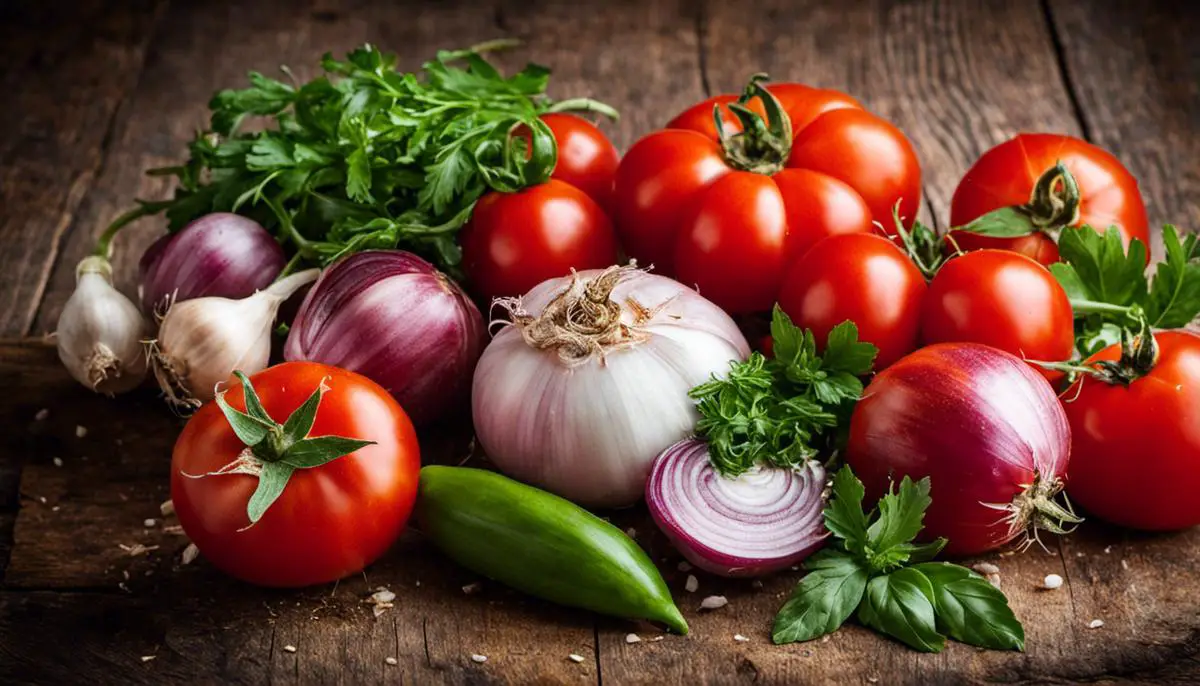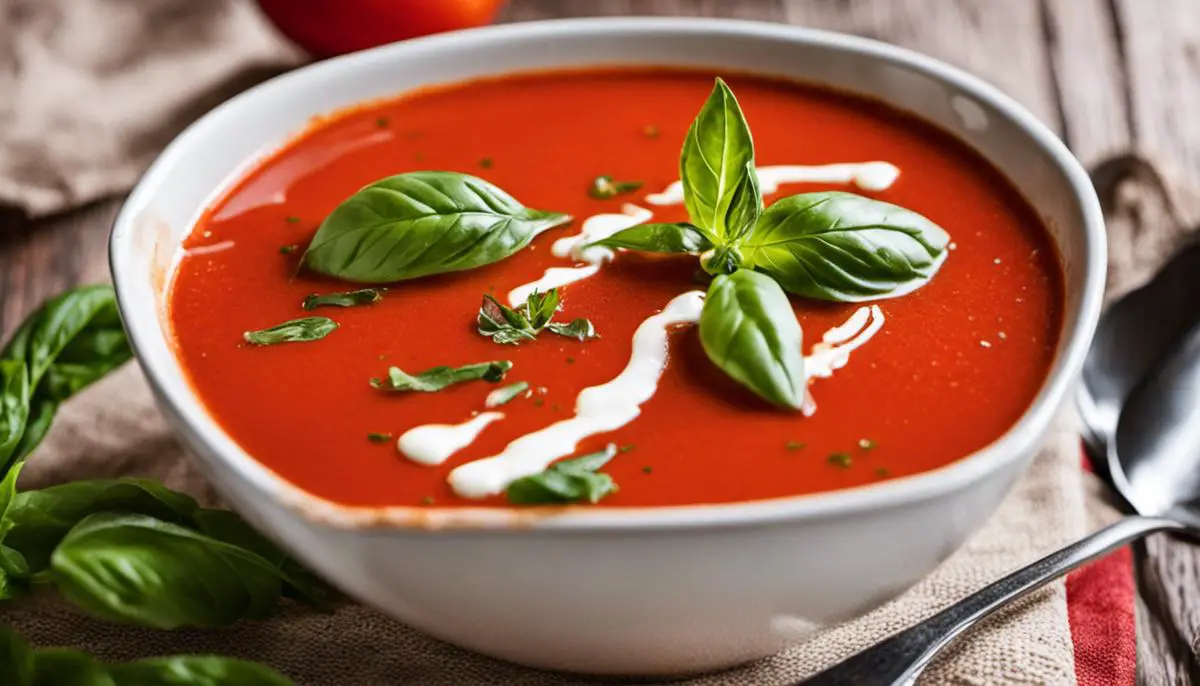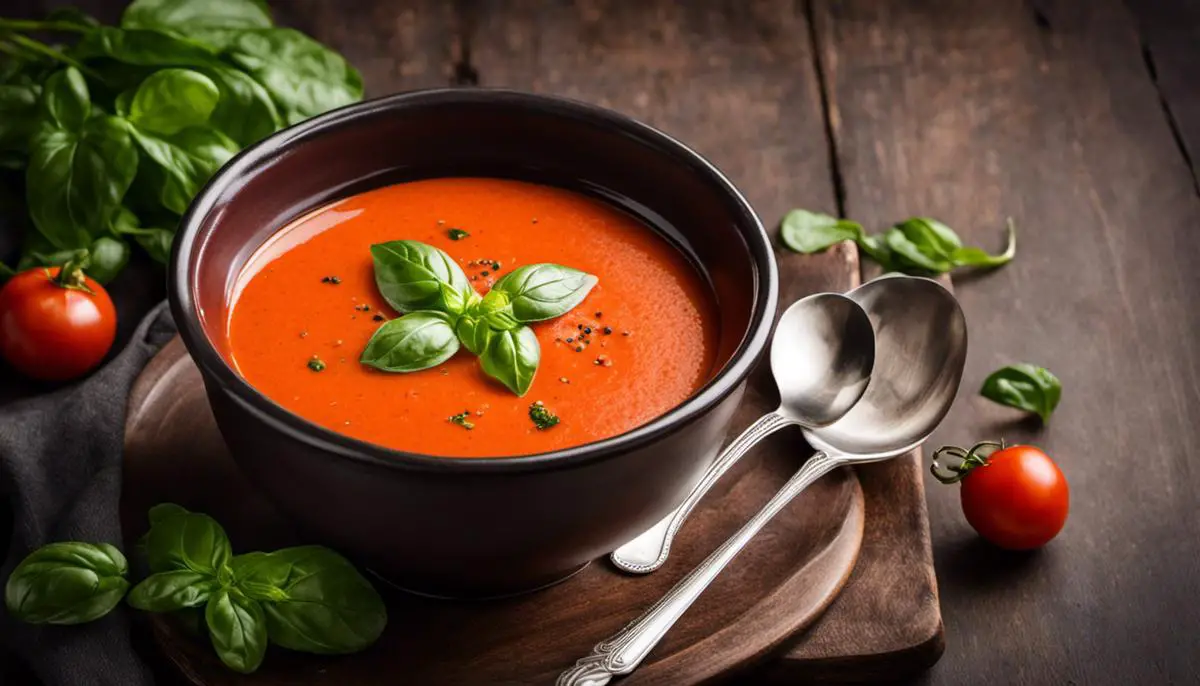Table of Contents
Delving into the rich, hearty world of tomato soup allows you to explore the culinary intricacies that make this classic dish a universal comfort food. The key to creating a noteworthy tomato soup lies in understanding its key ingredients, mastering the cooking process, and constantly practicing and tasting. By gaining in-depth knowledge about the diverse array of tomatoes best suited for soup and recognizing the unique contribution each ingredient makes to the overall flavor texture, you put yourself on the path to achieving a palate-pleasing soup. Moreover, learning and implementing various cooking techniques—like sauteing, simmering, and blending—enhances your kitchen skills while elevating the standard of the soup you create. The adventure doesn’t end here; the art of making tomato soup encourages experimenting with recipe variations and fine-tuning the taste to your liking, thus creating a genuinely personal culinary experience.
Understanding the Key Ingredients
Understanding Key Ingredients
When making tomato soup, understanding your essential ingredients is a crucial step. Firstly, pay attention to the type of tomatoes you’re choosing. Although there’s a variety of 7,500 different types of tomatoes worldwide, for soup, we’d recommend using Roma or Plum tomatoes, due to their low water and high flesh content, which provides soup with a rich and thick consistency.
Tomatoes are the backbone of your soup: they provide the base flavor and contribute tanginess. The ripest tomatoes are the best choice; they will offer a perfect balance between sweetness and acidity which is crucial to a well-flavored tomato soup.
Next, aromatics such as onions, garlic, and celery are typical additions that infuse depth to the character of your soup. Sautéing these ingredients until translucent creates a flavor base that infuses the soup with a savory complexity, counterbalancing the acidity of the tomatoes.
Spices like basil, thyme, and oregano can be used to enhance the tomato flavor. Depending on your preference, you can add a bit of heat with red pepper flakes or black pepper. Fresh herbs add a bright, summery note, while dried herbs give a more concentrated, earthy flavor.
Your choice of liquid is another key factor, with options ranging from water, chicken or vegetable broth. The latter two contribute more flavor and a slightly richer mouth-feel to the soup.
Lasty, cream is often used in tomato soup to give it a velvety, smooth consistency. It’s important to note that adding heavy cream to your soup is entirely optional, as not everyone prefers a creamy soup. Dairy-free alternatives such as coconut milk can also be used to achieve a creamy texture if you’re vegan or lactose intolerant.
Preparing Your Ingredients
Before you begin cooking, chop the vegetables into uniform sizes. Don’t worry about precision since they’ll be pureed later, but even sizes ensure even cooking. Blanch and peel the tomatoes – this will allow you to easily remove the skins which can sometimes give an unpleasant texture. Sauté the aromatic vegetables in a hot pan until they’re soft then add the spices and tomatoes. After adding your liquid, simmer the soup until all the vegetables are soft, and then blend until smooth. If using cream, stir it in last, after the soup has been blended.
Each ingredient adds its own special sendoff to the symphony of flavors that make up good homemade tomato soup. Knowledge of these ingredients and their unique contributions to your soup will help you better understand the recipe and make a delicious meal.

Mastering the Cooking Process
Ingredients Preparation
First, gather your ingredients. You will need about 2 pounds of fresh tomatoes (a combination of fresh heirlooms, cherry, vine, or plum tomatoes), 1 onion, 3 cloves of garlic, a handful of fresh basil leaves, and a quart of chicken or vegetable stock. The quality and freshness of your ingredients is crucial for the flavor of the soup.
Chopping Ingredients
Begin by dicing the onion and mincing the garlic. Cut your tomatoes into quarters. You don’t need to be precise with the size – the soup will be blended later. Keep the basil leaves whole for the moment.
Cooking Ingredients
Once your ingredients are prepped, heat a large pot on medium. Add a dash of olive oil, then toss in your chopped onions. Saute them until they become translucent. Add the minced garlic and cook for another minute or two. Take care to avoid burning the garlic, as it can give a bitter taste.
Adding Tomatoes
Add your quartered tomatoes to the pot next and stir until they’re well combined with the garlic and onions. Cook for about 10 to 15 minutes, until the tomatoes are breaking down and releasing their juices.
Adding Stock and Simmering
Pour in your stock and toss in the whole basil leaves. Here, you would want to bring your soup to a simmer but not a strong boil. A simmer is just below a boil — you’ll see some bubbles, but not many. Simmer the soup for about 15 to 20 minutes. Keeping the temperature at a constant simmer ensures that all the ingredients mingle together without overcooking.
Blending the Soup
After everything has had a chance to get acquainted in the pot, blend the soup. An immersion blender works great for this, but a standard blender will do just fine – just be careful! The soup will be hot, so use caution when transferring it to a blender. Blend until it reaches your desired consistency – leave it slightly chunky if you like, or make it smooth.
Final Steps
Finally, return the soup to heat to keep it warm until serving. Taste the soup and adjust with salt and pepper as needed. Optionally, you can add some cream for added richness or a tiny bit of sugar to cut the acidity of the tomatoes. However, your soup could be perfect as is. Just add a garnish of fresh basil or a drizzle of olive oil, and your homemade tomato soup is ready to enjoy!
Conclusion
These steps highlight the importance of respecting your ingredients, controlling your cooking temperature, and not rushing the process. It’s easy to overlook these basics, but mastering them will set you on the path to great cooking.

Practicing and Tasting
Mastering the Art of Tomato Soup
When it comes to preparing tomato soup, practice is key. Once you have a standard tomato soup recipe at your disposal, try it out multiple times to become familiar with the process. Begin by gathering your ingredients, which usually include fresh tomatoes, onions, garlic, vegetable or chicken broth, olive oil, salt, and pepper. Other common additions are sugar, basil or other herbs, and cream or milk.
Sauté the onions and garlic in olive oil until they are softened and translucent. Add the chopped tomatoes and cook them until they are tender. Then, add the broth and herbs if you’re using them, and let the soup simmer for a while to combine the flavors. Towards the end of the cooking time, some recipes call for adding a bit of sugar to cut the acidity of the tomatoes. Now is also the time to add any dairy if you’re using it to make a creamier soup.
Tasting as you cook is a vital part of perfecting tomato soup. As the flavors start to meld together, check the balance of flavors in your soup. It may need more salt, more sugar, or more broth. These adjustments will help you become instinctive about what your recipe needs without requiring exact measurements.
Experiment with your recipe to make it your own. For example, you might try adding carrots for extra sweetness, red pepper flakes for a hint of spice, or a splash of white wine for acidity. Fresh basil or roasted red peppers could add a different dimension to the soup’s flavor profile. Try using different tomato varieties, such as plum tomatoes for a thicker soup, or heirloom tomatoes for a more flavorful soup. The options are limitless and can be guided by your personal taste.
Each time you prepare tomato soup, it’s a chance to refine the recipe until it becomes second nature. With enough practice, you’ll be able to whip up a pot of comforting tomato soup that is perfect to your taste.

Investing time and effort in understanding each ingredient, mastering cooking techniques and methodically trying out variations in a tomato soup recipe, promises not only a delightful meal but a transformative culinary journey. This methodical process can prove to be a learning experience that enhances your cooking skills, as well as your ability to discern and appreciate the different flavors and consistencies. While the perfect tomato soup might seem like an elusive goal, remember, each attempt brings you closer to that delectable bowl brimming with flavors that linger on your palate, warming not just your taste buds, but your soul. With these insights, you are now ready to embark on your journey towards mastering the iconic tomato soup.

